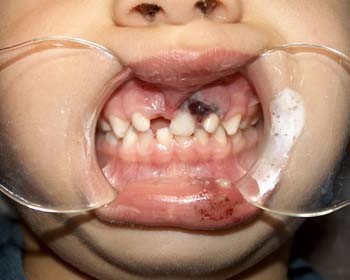Intraoral Exam
A systematic approach to the intraoral examination is critical. It is natural to focus on the area of injury, but this may cause other important clinical findings to be missed.

Procedure
- Irrigate to remove blood, clots, and debris.
- Examine mouth, including:
- Soft tissues
- Teeth
- Bony structures
- Assess the injured area, for the following:
- Tenderness and swelling
- Lacerations
- Damaged or mobile teeth: if fractured or avulsed tooth parts cannot be located, ascertain that the fragment is not embedded in the soft tissues or aspirated. Soft tissue x-rays may be needed
- Occlusion-ensure patient can bite together normally. Altered occlusion can indicate condyle or mandibular fractures while "steps" in the occlusal plane can indicate alveolar fracture.
- Mobile jaw segments
- Pain or limitation on opening which can indicate trauma to the temporomandibular joint or condyles.